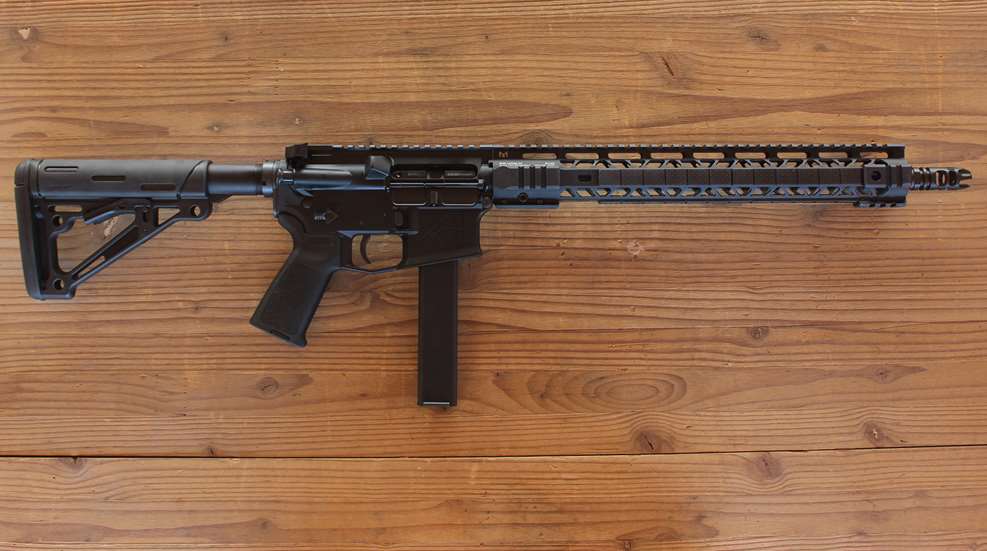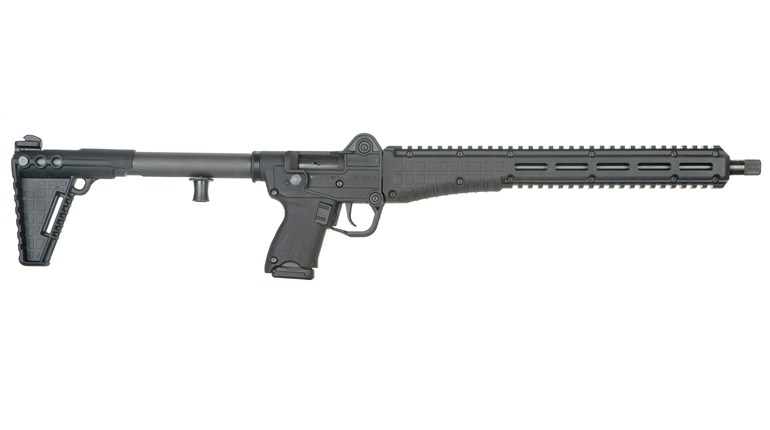
 At first glance, it seems like all AR-15 rifles are chambered for the .223 Rem./5.56 NATO cartridges. It's undoubtedly one of the most popular rifle-caliber options for this platform. However, over the last few years we've seen the rise in popularity of ARs chambered for the 9 mm pistol cartridge. The following is a walkthrough that explores the advantages of the 9 mm Pistol Caliber Carbine (PCC) version of the AR-15 for those who are just getting started with this popular modern sporting rifle. To help illustrate these points, I'll be referring to a 9 mm AR-15 consisting of a Black Dirt Rifleworks complete 9 mm upper receiver, an Aero Precision M4E1 complete lower receiver and a 9 mm magazine well block, all of which were provided by Ground Zero Precision (GZP) for this discussion.
At first glance, it seems like all AR-15 rifles are chambered for the .223 Rem./5.56 NATO cartridges. It's undoubtedly one of the most popular rifle-caliber options for this platform. However, over the last few years we've seen the rise in popularity of ARs chambered for the 9 mm pistol cartridge. The following is a walkthrough that explores the advantages of the 9 mm Pistol Caliber Carbine (PCC) version of the AR-15 for those who are just getting started with this popular modern sporting rifle. To help illustrate these points, I'll be referring to a 9 mm AR-15 consisting of a Black Dirt Rifleworks complete 9 mm upper receiver, an Aero Precision M4E1 complete lower receiver and a 9 mm magazine well block, all of which were provided by Ground Zero Precision (GZP) for this discussion.
Generally speaking, AR-15s are not what you could call inexpensive rifles no matter which caliber you choose. Yes, it is possible to find budget-friendly models in the $500 price range. I won't knock budget ARs because they certainly do have their place in the market. But starting off a beginner with the very least expensive version of any device may not contribute to their skills development as much as a higher quality option. Typical factory-installed, Mil-Spec triggers, for example, are not all that good. They can be mushy, gritty and have a trigger pull weight ranging from 5.5 to 8.5 lbs. A well-made mid-price rifle with an upgraded trigger (the one shown here has an MSRP of $1054) will feel better, last longer and operate more reliably making for a more positive shooting experience.
 One way to offset the cost of the rifle, and make range time more affordable, is to pick one that uses less-expensive ammunition. As of this writing, practice grade 9 mm purchased online costs around $0.05 less per shot than .223 Rem. A nickel a shot adds up quickly! But there are other benefits as well. The 9 mm pistol cartridge produces a low level of felt recoil when fired from a rifle, which reduces fatigue during practice sessions and aids in placing faster, more precise follow-up shots.
One way to offset the cost of the rifle, and make range time more affordable, is to pick one that uses less-expensive ammunition. As of this writing, practice grade 9 mm purchased online costs around $0.05 less per shot than .223 Rem. A nickel a shot adds up quickly! But there are other benefits as well. The 9 mm pistol cartridge produces a low level of felt recoil when fired from a rifle, which reduces fatigue during practice sessions and aids in placing faster, more precise follow-up shots.
Using a rifle chambered in 9 mm can save money in some other ways as well. One of the reasons I would consider the GZP rifle shown here as a great beginner's gun is the configuration of the Aero M4E1 lower assembly. Many of the 9 mm lowers on the market are dedicated lowers, meaning, they can only be used with 9 mm uppers and popular pistol magazines like those made for Glock-type pistols.
 However, this receiver is actually a .223 Rem. version outfitted with a removable caliber conversion block installed in the magazine well. The polymer block shown here supports Colt style 9 mm magazines, which are tough, reliable and fairly inexpensive to purchase. If the block is removed, the lower is once again compatible with standard Mil-Spec AR-15 magazines. This means that if this is your first AR-15 purchase you already have a lower receiver assembly that's compatible with a variety of cartridges in addition to 9 mm. So if you choose to try another caliber, you only need to buy the upper half of the rifle instead of a whole one.
However, this receiver is actually a .223 Rem. version outfitted with a removable caliber conversion block installed in the magazine well. The polymer block shown here supports Colt style 9 mm magazines, which are tough, reliable and fairly inexpensive to purchase. If the block is removed, the lower is once again compatible with standard Mil-Spec AR-15 magazines. This means that if this is your first AR-15 purchase you already have a lower receiver assembly that's compatible with a variety of cartridges in addition to 9 mm. So if you choose to try another caliber, you only need to buy the upper half of the rifle instead of a whole one.
 In the good old days, soldiers, hunters and pioneers would pair up a handgun with a pistol-caliber carbine chambered in the same cartridge for use in the field. Since both guns could be fed out of the same boxes of ammunition, only one caliber of ammunition has to be tracked down, purchased and kept on hand. This same principle can be practiced today by pairing a 9 mm carbine with a 9 mm semi-automatic pistol.
In the good old days, soldiers, hunters and pioneers would pair up a handgun with a pistol-caliber carbine chambered in the same cartridge for use in the field. Since both guns could be fed out of the same boxes of ammunition, only one caliber of ammunition has to be tracked down, purchased and kept on hand. This same principle can be practiced today by pairing a 9 mm carbine with a 9 mm semi-automatic pistol.
With a bit of time and expense up front, the rifle and handgun can be tested with practice-grade and defense-grade loads to find out which brands and bullet weights run reliably and accurately in both. Once identified, ammunition can then be purchased when it's on sale or in bulk. If you choose to reload your spent cartridge cases, having only one caliber to work with will also save money on components, dies, powder and primers.
For home defense, two guns are better than one. One responsible adult can take the rifle while the other makes use of the handgun. The 9 mm cartridge is one of the most common calibers used around the world for military, law enforcement and civilian applications. This means that millions of dollars have gone into improving defensive bullet designs and cartridge effectiveness over the last couple decades. This improvement in cartridge performance combined with carbine magazine capacities of up to 32 rounds provides a level of fire power that should not be to be taken lightly, especially at home-defense distances.
 AR-15 carbines are often outfitted with 16" barrels, like the GZP model pictured here. An AR chambered in .223 Rem. has an effective range of around 400 to 650 yards (depending on the quality of the gun and ammunition used). The 9 mm carbine is limited to about 100 yards for self defense applications with a maximum target shooting range of around 200 yards. However, compared to 9 mm pistols, the carbine offers distinct performance advantages. Generally speaking, 9 mm pistols feature 3" to 5" barrels capable of solid defensive accuracy (3.5" 5-shot group averages) at 25 yards in the hands of a relatively experienced shooting enthusiast.
AR-15 carbines are often outfitted with 16" barrels, like the GZP model pictured here. An AR chambered in .223 Rem. has an effective range of around 400 to 650 yards (depending on the quality of the gun and ammunition used). The 9 mm carbine is limited to about 100 yards for self defense applications with a maximum target shooting range of around 200 yards. However, compared to 9 mm pistols, the carbine offers distinct performance advantages. Generally speaking, 9 mm pistols feature 3" to 5" barrels capable of solid defensive accuracy (3.5" 5-shot group averages) at 25 yards in the hands of a relatively experienced shooting enthusiast.
Not only does the carbine’s added barrel length increase the cartridge’s range, it boosts the close range power levels due to the longer burn time for the powder charge. The degree to which power levels are increased depends on the load fired. The following table shows the manufacturer's listed pistol performance information for three loads including two defense-grade hollow points from Double Tap and Sig Sauer along with one practice grade load from Winchester. Take a look at how that compares to the 16" barrel rifle results. The gains in muzzle velocity and energy are noteworthy, especially for the +P hollow point load:

Whenever possible, it makes sense to invest in firearms that can fill multiple roles instead of just one. The 9 mm AR-15 falls neatly into this category. A quality model can move comfortably between a day of plinking at the shooting range, being staged for home defense and ringing close-range steels at a weekend competition that has stages set up for pistol-caliber carbines. Imagine spending a day honing your shooting skills at a match, getting home, giving your carbine a quick cleaning and then staging the gun you know best, inside and out, to protect your home in case of an emergency. That's about as flexible as a rifle gets!
To learn more about the 9 mm AR-15 rifle components mentioned here, visit Ground Zero Precision.
 9 mm AR-15 Carbine Components:
9 mm AR-15 Carbine Components:
Complete Upper: GZP Black Dirt Rifleworks 16" TH1615 9 mm AR15, $455
Complete Lower: GZP Aero Precision M4E1 M4/LE .223/5.56 Carbine $175 - $350
Removable Magwell Adapter: GZP Black Dirt Rifleworks 9mm AR-15 Colt Mag Compatible $94.99
Trigger Upgrade: GZP Black Dirt Rifleworks BDR-1510 Advanced Match Trigger $125
ASC Magazines 9 mm AR-15 Stainless Steel Magazines, 10-, 20- or 32-round $15.99
Brownells 32-Round 9 mm AR-15 Colt Style Magazines, Single $37.99, 3-Pack $106.99















































